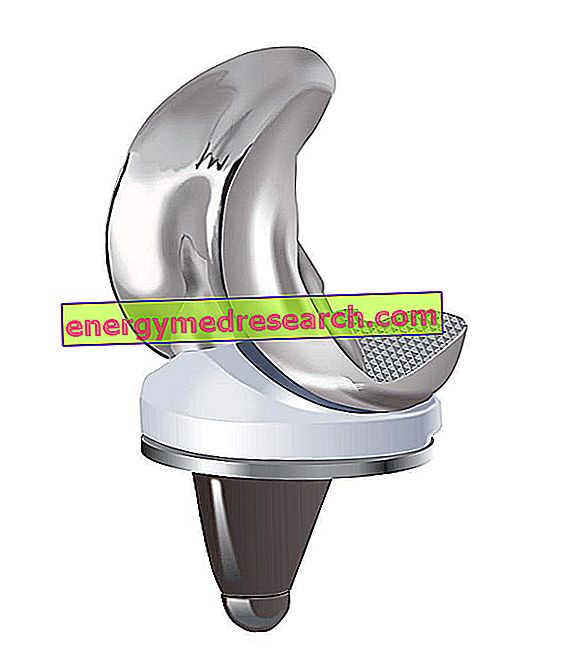Definition of epididymitis
In the medical field, "epididymitis" means a morbid condition of an infectious / inflammatory nature affecting the epididymis. In this article, attention will be focused on the various forms of epididymitis present and on the symptom picture that follows.
Classification
There are several forms of epididymitis, classified according to the severity of the disorder and the predisposing aetiological factor:
- Acute bacterial epididymitis: typical complication of bacterial prostatitis, urethritis and bacteriuria (bacteria in the urine), it can be unilateral (affects only one epididymis) or bilateral, when both epididymis are inflamed. By touch, the epididymis - and sometimes even the testicle - are swollen, stiff and painful, often accompanied by erythema. When the inflammatory process extends to all the anatomical structures that include the spermatic cord, the epididymitis evolves into funiculitis, while when the inflammation affects the vas deferens, in addition to the epididymis, one speaks of deferentite . Many patients with acute bacterial epididymitis are also affected by urethritis, and show infected urine and urological abnormalities.
- Chronic epididymitis: acute epididymitis, when left untreated or not properly treated, could evolve into its chronic form, in which the inflammatory process occurs without bacterial infection. However, chronic epididymitis may also appear following a correct and targeted resolving intervention of acute epididymitis, as the genital anatomical structures become more fragile, delicate and sensitive: in this regard, these structures are more subject to epididymitis, precisely because it was previously injured. In similar situations, the only possible solution is surgery.
Both forms of epididymitis may have a bacterial-specific origin (especially gonococcus, brucella) or non-specific (eg Gram-negative in general) - non-bacterial (eg mycotic, however rare) or traumatic.
Another form of epididymitis, which also affects the testicle is known as orchi-epididymitis, often resulting from gonorrhea, secondary infections caused by an indwelling catheter; sometimes, the orchi-epididymitis represents the most immediate complication of urinary tract infections associated with urethritis or prostatitis. Even a complication following prostatic surgery can cause inflammation of the epididymis.
In general, orchi-epididymitis has a non-specific bacterial origin (gram-negative), although Chlamydía trachomatis is isolated in some patients: these gram-negative ones cause swelling in situ, associated with erythema and scrotal edema.
However, there is also the non-bacterial form of orchi-epididymitis: in this case, the etiology is uncertain, although many authors believe that the retrograde spread of infected fluids through the vas deferens may constitute an acceptable causal element.
When inflammation, pain and the sensation of swelling affect only the testicle, without affecting the epididymis, we speak more precisely of orchitis .
Another form of epididymitis, already mentioned in the introductory article, is chemical epididymitis, characterized by urinary reflux inside the vas deferens: in similar situations, the pathological condition is a consequence of the administration of particular drugs (eg amiodarone) or of the excessive physical effort.
Epididymitis: symptoms
To learn more: Epididymitis symptoms
The symptomatic picture of epididymitis varies according to the severity of the condition; often the affected patient complains of a slight alteration of the basal temperature (low-grade fever) which frequently turns into a real fever. Testicular pain and the presence of a rigid and solid mass inside the scrotal sac are symptoms present in most cases, and are caused, in particular, by lesions of the epididymis (eg tuberculous nodules); if in the epididymis the lesions occur early, that is to say from the onset of the disease, at testicular level, instead, the tension, the rigidity and the formation of nodules appear later. Just to avoid the spread of lesions in the surrounding sites, the therapeutic intervention should be immediate.
More generally, among the most frequent symptoms related to epididymitis we mention: painful ejaculation, pain during intercourse (dyspareunia), scrotal redness / swelling, genital inflammation, chills, swollen lymph nodes, dysuria, urethral leakage and pain at the lower abdomen.
The epididymitis caused by tuberculosis deserves further investigation, since the symptomatic profile of the affected patients is more complex and articulated: tuberculosis affecting the epididymis begins with characteristic swollen nodules, located at the level of the lower part of the testicle. The nodules generate feelings of heaviness and generalized genital soreness; when the tuberculous epididymitis is accompanied by fever and acute pain, in all likelihood the disease is also related to bacterial infections.
Complications
Epididymitis must never be neglected, nor minimized or underestimated: it is a pathology in all respects that could sometimes generate very serious damage. Testicular pain, for example, could degenerate and cause permanent damage, causing, for example, decreased fertility. The most serious risks include the scrotal abscess (a possible condition when the tissues affected by the infection produce pus), and the narrowing of the testicle affected by the epididymitis.
Sometimes, the epididymitis could be wrongly diagnosed as testicular torsion, conditions very similar from the symptomatological point of view: however, the diagnosis must be precise and unequivocal, since the twisted testicle is a pathology much more serious than, constituting a serious risk for testicular circulation, urgent urgent intervention is required.



